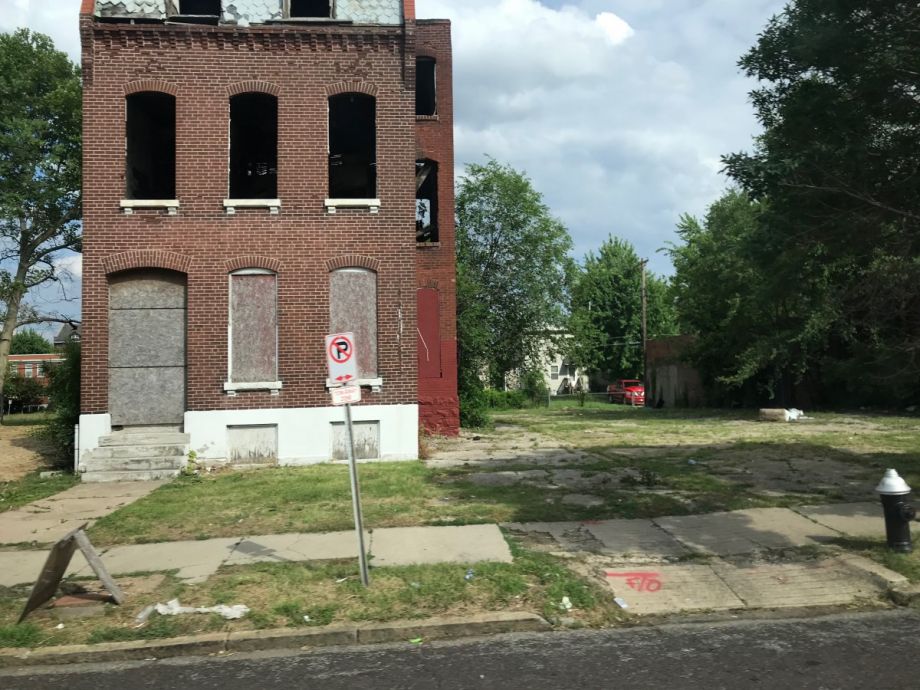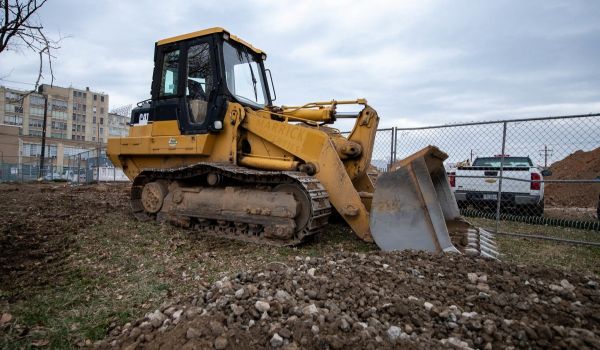When Eric Schwarz first founded Refab, a St. Louis non-profit that takes apart buildings to salvage materials, he says the neighbors of the first job site ran him out of their working-class community.
“The residents are very protective of their buildings,” Schwarz says. “They don’t want to see them come down, and arguments like ‘some of them need to come down so you all can have materials to fix your homes’ wasn’t what they wanted to hear.”
Six years later, Refab has won the city’s first deconstruction contract and has helped catalyze a shift in perspective about deconstruction.
Deconstruction differs from demolition by painstakingly picking buildings apart to salvage the materials and use them again. Compared with demolition, deconstruction decreases the level of toxins, such as lead and asbestos, released into the environment when a building is taken down. A 2006 Tulane University study found that demolitions contribute to lead exposure in children who live in the vicinity. It also decreases waste, obviously.
“We’re taking a situation where there’s a bunch of materials that would be landfilled,” Schwarz explains, describing how Refab captures the materials used in St. Louis-area buildings to sell for reuse. It’s new territory in the St. Louis area, where the Land Reutilization Authority, the city’s land bank, owns some 12,000 vacant buildings. Land banks are generally a public or community-owned entity that temporarily holds properties, for example, that were foreclosed on for back-taxes or other debts, but not sold at a tax auction.
Now, as a result of a consent decree between the Metropolitan St. Louis Sewer District and the Environmental Protection Agency, St. Louis has $13.5 million to spend on “deconstructing” this wealth of unwanted buildings. The aim is to increase the amount of permeable surface that can absorb rain and other precipitation instead of sending it into an overworked sewer system and causing overflows. Also, as it turns out, open space on vacant lots helps native honeybee populations restore themselves.
An investment in creating a new deconstruction industry might be justified as part of environmental sustainability initiatives. “I’m really excited about what’s going on with the potential green jobs New Deal — that could be huge,” Schwarz says.
When he started Refab, Schwarz wanted to help veterans find work while preserving bits of local history. Up till now, he says, 42 people have been through the organization’s training program, and some have stayed on, but Schwarz says that the success rate is only about 40 percent.
Success means “they’ve trained with Refab and then gone on to another job,” says Schwarz. “Those jobs are usually green jobs or more construction-related jobs.” Others have gone on to work in waste and recycling or in abatement.
“The super capable ones go one to the abatement industry,” he says. “Those jobs pay really well.”
Asked why fewer than half of the program participants come out on the other side, Schwarz doesn’t mince words. “The 60 percent guys, they were either unfit to work on the job site or got themselves fired because a lot of things like theft or not showing up to work, drugs,” he says. Schwarz points people to drug treatment programs, but, he says, “pretty few come back.” This high attrition rate, Schwarz says, is something his organizational partners acknowledge as a common phenomenon.
As he gears up for the pilot project with the city, Schwarz says that Refab will tighten its hiring focus. “We’ll hire people from the neighborhoods where we do the deconstruction,” he says. “We’re going to take tax dollars and put them into the pockets of the residents who are affected by this activity in their neighborhood.”
With a current staff of nine people, Refab has come a long way from the one-man operation it was in 2012 with just $3,000 to get the operation off the ground. Schwarz expects the crew to balloon to roughly 36 next year when the city launches its 30-building deconstruction pilot project. That pilot is a collaboration known as the Green City Coalition, a partnership between the City, the St. Louis Development Corporation, Metropolitan St. Louis Sewer District, and the Missouri Department of Conservation.
Laura Ginn, a program manager with the St. Louis Development Corporation, says the Green City Coalition pilot will help determine the city understand the challenges tied to a large-scale deconstruction project as well as the opportunities it offers.
“We’re going from less than 200 demolitions a year to at least 800, real quickly,” Ginn says. “So, what are the various strategies we need to put in place to be sure we’re creating opportunities out of that?”
Deconstruction offers the potential for jobs both in the taking apart and in creating new items for sale out of salvaged materials. Schwarz says Refab has been shifting away from taking down St. Louis-area barns to focus on urban deconstruction, and that it is developing a value-added component.
“We’re going to have a value-added workshop that will be rolling out in the next month or so,” Schwarz says. “That’s taking lumber that you can wholesale at $1.50 a board but selling it for $15 by turning it into a table.”
Transforming salvage materials into new products this way is one approach to re-using materials instead of landfilling them. Still, Schwarz cautions that “there’s a barrier to re-use.”
“Contractors say ‘I love the look, but working with that stuff is a pain in the ass, my guys don’t know how to do it, the sizes are different, it takes too much time,’” Schwarz says. “If we can reduce that barrier to re-use, we’ll see more re-use happen.”
Meanwhile, the Delta Institute, a Chicago-based nonprofit focused on “thriving communities and landscapes,” has been working with the City of St. Louis on demolition programs. The institute prepared a demolition handbook, released in November, and is currently analyzing the potential economic impact of a large-scale deconstruction project in St. Louis.
“We’re interviewing lots of folks who do value-added processing with these materials, so we’re definitely taking their temperature on ‘how would you respond if all of a sudden there was all this reclaimed lumber?’” says Martin Brown, a researcher with the Delta Institute. That report will be ready early in 2019.
Another aspect of the pilot will be a collaboration with St. Louis Community College to offer deconstruction training. By preparing students as well as current professionals to become demolition and construction contractors, Brown says, “the training will be partially engaging some new people in the industry through the community college network, but also training people in adjacent industries like demolition and construction.”
One potential benefit of training people who are already working in related fields, Brown says, is that they may integrate some deconstruction practices into their existing projects, even if they aren’t full-fledged deconstruction undertakings.
For Schwarz, this training is a way to expand the playing field. “Refab certainly does not want to be the only contractor involved with this,” he says. “We want to help foster a thriving deconstruction and material re-use industry here and not be the sole awardee of all these city contracts.”

Zoe Sullivan is a multimedia journalist and visual artist with experience on the U.S. Gulf Coast, Argentina, Brazil, and Kenya. Her radio work has appeared on outlets such as BBC, Marketplace, Radio France International, Free Speech Radio News and DW. Her writing has appeared on outlets such as The Guardian, Al Jazeera America and The Crisis.
Follow Zoe .(JavaScript must be enabled to view this email address)
















